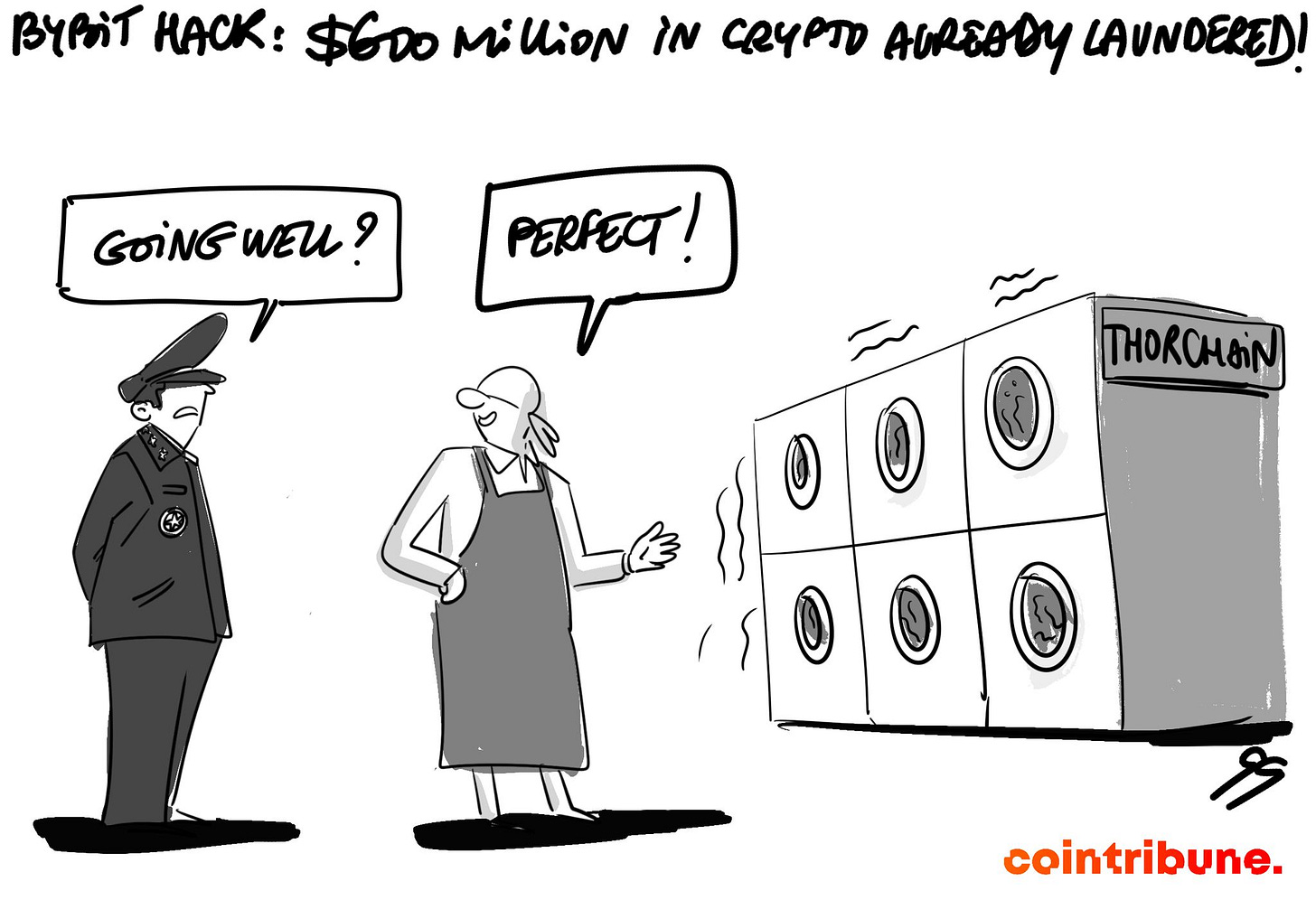🚨 Bybit Hack: $600M Laundered in a Week, North Korea Defies the FBI!
Welcome to the Daily Tribune of Saturday, March 1, 2025 ☕️
Happy New Year to Cointribu! 🚀
Today is Saturday, March 1, 2025, and as every day from Tuesday to Saturday, we summarize the news from the last 24 hours that you should not miss!
But first…
✍️ Cartoon of the day:
A quick look at the market…
🌡️ Temperature:
Sunny ☀️
24h crypto recap! ⏱
🚨 Bybit Hack: Already $600 Million Laundered by North Korea!
The Bybit hack, orchestrated by the Lazarus group, has already facilitated the laundering of $605 million in ETH in a week, which is 54% of the total loot. The hackers exploited THORChain, an inter-chain protocol allowing exchanges without KYC, to disperse the funds in record time. The situation divides the DeFi community: should we strengthen censorship to combat crime, or preserve anonymity and decentralization? While the FBI demands measures against suspicious transactions, hackers continue to profit from the weaknesses of open protocols. 🔗 Read the full article
📈 Pi Network Explodes by 35% and Reaches a New ATH!
The Pi Network token (PI) surged by 35% on Thursday, reaching a new all-time high with a market capitalization of $16 billion. This excitement is explained by a massive increase in trading volumes, exceeding $2.3 billion, and ultra-bullish technical indicators. However, some overheating signals raise concerns about a sharp correction, while the rumor of a listing on Binance fuels speculation. If PI surpasses $3.50, a rally towards $4 seems possible, but a drop towards $1.70 could also occur if the trend loses steam. 🔗 Read the full article
🔥 MetaMask Integrates Bitcoin and Solana and Kills Gas Fees!
MetaMask strikes a big blow by adding support for Bitcoin and Solana, while implementing a new system to eliminate gas fees. Starting May 2025, users will be able to pay their fees with any token held, removing the issues of fluctuating gas fees. Additionally, a new Smart Transactions feature achieves a success rate of 99.995%, making exchanges 400 times more reliable on Ethereum and 7,000 times smoother on Solana. With over 30 million users, MetaMask has established itself as the essential wallet of Web3. 🔗 Read the full article
🇺🇸 Tokens TRUMP and MELANIA Soon to be Banned in the United States?
In light of the plummet of TRUMP tokens (-82%) and MELANIA (-93%), the U.S. Congress is preparing a law aimed at banning political figures from issuing or promoting cryptos. The project, dubbed the MEME Act, aims to prevent abuses and protect investors, after 813,000 wallets have suffered massive losses. If this law passes, memecoins linked to public figures could disappear from the U.S. market, marking a major turning point in crypto regulation. 🔗 Read the full article
Crypto of the Day: Celestia (TIA)
Celestia is a modular blockchain that separates consensus functions and data availability from transaction execution. This architecture allows developers to quickly and easily deploy their own custom blockchains, without needing to manage a dedicated set of validators. By focusing on data availability and consensus, Celestia offers increased scalability and flexibility for decentralized applications, thus allowing complete customization of the technology stack.
The native token of Celestia, TIA, is used to pay transaction and data storage fees on the network. TIA holders can also participate in the consensus mechanism by delegating or staking their tokens, thereby contributing to the network's security while earning rewards. Additionally, TIA serves as a governance token, allowing holders to participate in decisions regarding the protocol's evolution. The initial distribution of TIA was conducted via an airdrop aimed at contributing developers of the project, as well as certain users of Ethereum's Layer 2 solutions, Cosmos (ATOM) stakers, and Osmosis (OSMO) holders.
Recent Performance:
Current Price: $4.13 (approximately €3.90)
24-hour Change: +20.7%
Market Capitalization: $2.22 billion
Rank on CoinMarketCap: #41
Shocking Predictions from River on Bitcoin: An Underexploited Potential
The exchange platform River has published a report detailing optimistic predictions regarding the future of Bitcoin. According to this analysis, the adoption of Bitcoin is just beginning, comparable to the early phase of the Internet.
River estimates that less than 4% of the global population holds Bitcoin, with higher rates in the United States (14%) than in Europe (3.4%). The study highlights three major factors that could propel Bitcoin towards massive adoption:
A potential replacement for traditional assets
Bitcoin could capture 25% of the wealth currently invested in assets like gold, prestigious real estate, or art.
Currently, $225 trillion are still allocated to these assets, a market that Bitcoin could gradually penetrate.
Underinvestment by financial institutions
Investment funds managing $128 trillion currently allocate less than 0.0006% to Bitcoin.
In comparison, stocks dominate at 53%, followed by corporate bonds (12.5%) and government bonds (10%).
Increased adoption by states and institutions
Today, 18 countries hold Bitcoin, mainly through mining (Bhutan, El Salvador, Iran, Ethiopia), through criminal seizures (United States, China, United Kingdom), or through direct purchases (United Arab Emirates).
River forecasts that a G20 country could announce holding Bitcoin within four years, due to the gradual abandonment of U.S. Treasury bonds as a reserve asset.
In the United States, Senator Cynthia Lummis advocates for Congress to buy between 1 and 5 million BTC, although River considers this scenario unlikely.
Bitcoin vs. Gold and the Dollar: An Increasingly Rare Asset
River also highlights the impact of the April 2024 halving, which has halved the number of new BTC created per day (from 900 to 450 BTC). This scarcity makes Bitcoin a harder asset to obtain than gold, whose production continues to increase by 2% per year, compared to 0.85% for Bitcoin.
Current Distribution of BTC in Circulation:
70% held by individuals
6% held by ETFs (e.g., BlackRock)
4.4% held by companies (e.g., MicroStrategy)
1.4% held by states
10% estimated as permanently lost
If the United States followed Michael Saylor's recommendation and bought 20% of the BTC, it would transform Bitcoin into a strategic asset on par with gold.
Decentralization and Technical Adoption: The Bitcoin Network in Full Expansion
The Bitcoin network continues to strengthen with an 11% increase in the number of nodes in 2024 (21,700 active nodes). Mining is now largely distributed among the United States (36%), Russia (16%), and China (14%). The computing power has also exploded, reaching nearly 800 exahash, or 800 trillion trillion calculations per second.
However, a point of concern remains: the concentration of mining pools, where the three largest pools still control over 60% of the network. This phenomenon could lead to censorship risks on certain transactions.
Towards a Bitcoin Worth Several Tens of Millions of Dollars?
River predicts that Bitcoin will ultimately replace the dollar as the world reserve currency. The study suggests that the value of a single BTC could reach several tens of millions of dollars in the long term.
Although this perspective may seem optimistic, the long-term trend supports this vision:
Growing adoption by individuals, businesses, and states
Increased scarcity with the halving and growing holdings by institutions
Reinforced decentralization, despite challenges related to mining concentration
However, the report emphasizes that the coming years will be crucial: regulation, state decisions, and the evolution of traditional asset markets could influence this upward trajectory.
Conclusion
River projects a bright future for Bitcoin, estimating that we are still only at 3% of its full adoption potential. The evolution of the market will depend on the choices of institutions, regulations, and global economic trends. The story of Bitcoin seems far from over, and its role as a global asset is just beginning.









